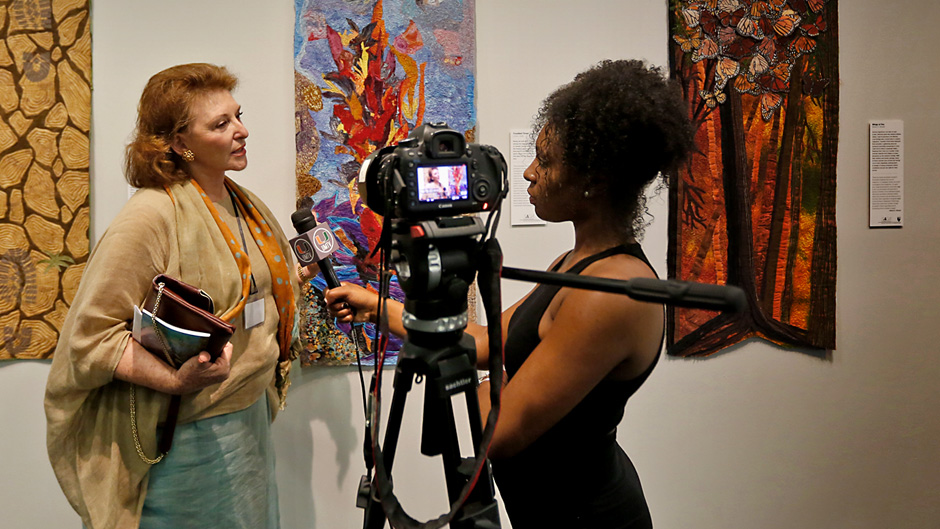A traveling exhibit of 26 colorful and intricate climate-focused art quilts by 22 Florida artists, “Piecing Together a Changing Planet,” survived wildfires and a hurricane to open on Wednesday evening at the Otto G. Richter Library at the University of Miami.
Seamless complements to the art quilts, interactive multimedia displays and curated library items invite guests to explore a range of climate change issues and how a changing planet is particularly affecting South Florida.
Though certainly one of the most pressing and extremely relevant issues of our time, especially in Miami, climate change and its impacts are not insurmountable.
“The drive to overcome adversity is embedded in the University of Miami’s history,” said UM President Julio Frenk during the exhibit opening. “And now, in the face of growing vulnerability to rising sea levels, we are mobilizing vital resources to protect and preserve our home, while also sharing our innovative solutions to benefit people and places around the world.”
Frenk was introduced by Charles Eckman, dean of UM Libraries, whose team researched and selected the various materials on display to illustrate progress made to protect the environment, risks posed to people and property, and even tools to help us better understand and provide answers to the questions posed by our changing planet.
At the reception held in the Roberto C. Goizueta Pavillion of the Cuban Heritage Collection (CHC), Dean Eckman remarked that the CHC “is an ideal setting for the conversation of climate change research, science and art as it represents an important resource created through sustained collaboration and dialogue across the academy and the community.”
The textile artwork has been visiting National Parks throughout the United States since 2014. Each unique piece examines climate change impacts such as sea level rise and coral bleaching, water and air pollution, and flora and fauna habitat loss—many of which are impacting some of the nation’s 400 landmarks managed by the National Park Service.
Representatives from the exhibit’s first stop in 2014—Biscayne National Park—were at the UM opening and were joined by several of the exhibit’s textile artists from Studio Art Quilt Associates (SAQA), an international nonprofit dedicated to promoting art quilts and the fiber artists who create them. Maya Schoenberger, project curator, had the initial idea for “Piecing Together a Changing Planet” and first approached Gary Bremen, park ranger for Biscayne National Park, three years ago.
On behalf of SAQA, Linda Eads, a UM alumna, artist, educator and founder of the nationally acclaimed MAST Academy, spoke during the opening reception and was grateful to UM for “the creative adventure of blending science and art to communicate our mutual concern for changing environmental conditions.”
In an engaging and interactive multimedia display, University Communications and UM Libraries highlight work by researchers, faculty, students and alumni in the areas of climate change and sustainability through a digital presentation and a curated exhibition using historic and contemporary collection items, ranging from environmental zines and archival photograph albums to a Mosquito vs. Human card game meant to describe vector-borne diseases.
The opening welcomed a diverse crowd of curious and conscientious guests, including faculty, staff, artists, community members, and students.
A cohort from the student group, Energy and Conservation Organization (ECO-Agency), engaged with the exhibit and other attendees about the work their organization is accomplishing in the UM community. They were also there to support their chair, Josh Lomot, a UM senior in environmental management, business, and policy. As chair, Lomot remarked, he receives weekly requests from students and faculty alike on how best to become involved in finding sustainable solutions for our changing planet.
“These messages give me hope, and they give me confidence that even as we begin to see more dramatic effects of climate change in our everyday lives, there are enough people at UM alone, willing to not just sit back and admit defeat, but rise to the challenge and find a solution,” said Lomot.
“The passion and eagerness of others in the UM community to take problems into their own hands, find solutions, and make an impactful change,” Lomot added, “make me optimistic for our generation’s role in solving the issues of climate change.”
The art quilts traveled to Miami from Gatlinburg, Tennessee, where the pieces survived raging wildfires that ripped through the Great Smoky Mountains in late 2016. The exhibit will be on display on the first floor of the Richter Library through April 7.

